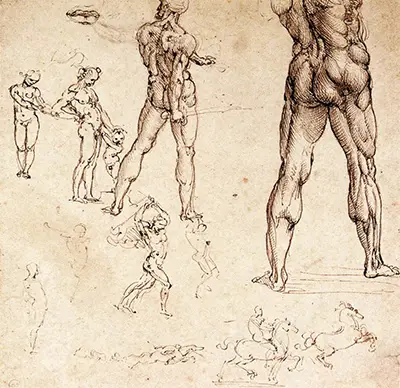In this particular treatise, scholar Leon Battista Alberti asked painters to develop the human figure as it exists in nature, bolstered by the skeleton and musculature, and at exactly that point dressed in the skin.
Despite the fact that the date of Leonardo's underlying inclusion with anatomical studies isn't known, it is sound to hypothesize that his anatomical intrigue was started amid his apprenticeship in Verrocchio's workshop, either in light of his lord's advantage or to that of Verrocchio's neighbour Pollaiuolo, who was eminent for his interest in the workings of the human body.
It can't be stated precisely when Leonardo started to perform anatomical studies, yet it may have been quite a long while after he initially moved to Milan, at the time a major centre of medical examination.
His anatomical studies, initially sought after for his study as an artist, had developed by the 1490s into an independent area of research.
As his sharp eye revealed the structure of the human body, Leonardo ended up plainly entranced by the man's instrumental figure, and he looked to understand its physical acting as a production of nature. Over the following two decades, he did analytical and practical work in life systems of the human body on the dissection table in Milan.
Then he proceeded to hospital centres in Rome and Florence where he did the same practice. Leonardo then headed to Pavia where he teamed up with a physician and anatomist Marcantonio Della Torre. According to his counting, Leonardo conducted 30 dissections on corpses in his entire lifetime.
Leonardo's initial anatomical studies dealt mainly with the skeleton and muscles; yet even at the start, Leonardo consolidated anatomical with physiological research. From watching the static structure of the body, Leonardo continued to examine the part of individual parts of the body in mechanical action.
This drove him at last to the investigation of the interior organs; among them, he examined most profoundly into the brain, heart, and lungs as the "engines" of the senses and life. His discoveries from these investigations were recorded in the famous anatomical drawings, which are among the major accomplishments of Renaissance science.
In Leonardo’s drawings, he portrayed parts of the body in straightforward layers that bear the cost of understanding into the organ by utilising segments in context, recreating muscles as "strings," showing shrouded parts by dabbed lines, and formulating a bring forth framework.
The abundance of Leonardo's anatomical studies that have survived manufactured the fundamental standards of present-day scientific investigation. It is significant, in any case, that amid his lifetime, Leonardo's restorative studies stayed private. He didn't see himself as an expert in the field of anatomical studies, and he neither instructed nor distributed his discoveries.
Despite the fact that he hushed up about his anatomical studies, Leonardo published some of his findings on the human body. Working with the mathematician Luca Pacioli, Leonardo considered the corresponding hypotheses of Vitruvius.
Forcing the principles of geometry on the arrangement of the human body, he exhibited that the whole extent of the human figure compares with the types of the circle and the square.
In his representation of this hypothesis, the alleged Vitruvian Man, Leonardo showed that when a man puts his feet immovably on the ground and extends his arms, he can be contained inside the four lines of a square, however, when in a spread-bird position, he can be recorded around.


